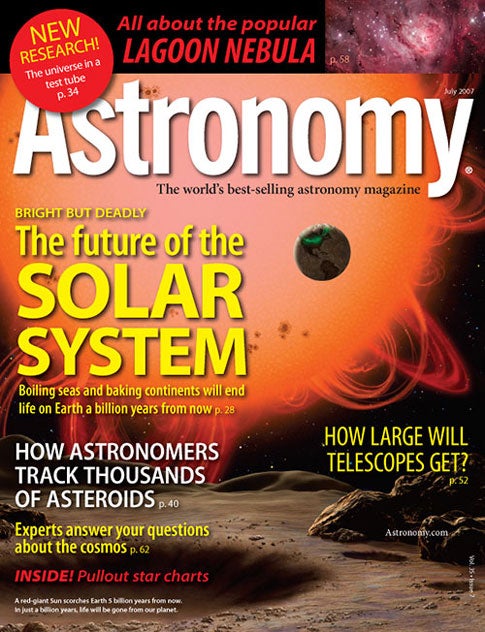
What will life on Earth look like a billion years from now? How can scientists capture the universe in a test tube? How large will telescopes get? The July 2007 issue of Astronomy answers these questions and more.
More resources from Astronomy.com:
- Astronomy news
This week’s sky events
Astronomy basics
Glossary of astronomical terms
Return to Astronomy “For the media” page
• “All about the Lagoon Nebula” – Explore the brightest stellar birthplace in the summer Milky Way.
• “Starry virtuoso” – Celebrated for his mastery of deep-sky observing, Brian Skiff is also one of the most amateur-friendly astronomers.
• “MaxCam gets imagers started” – Finger Lakes Instrumentation’s MaxCam ME2 CCD camera offers a host of features in a small package.
• “The brass and glass of astronomy’s past” – Antique telescopes and globes fill the exhibit halls of Chicago’s Adler Planetarium.
• The July 2007 Astronomy also includes Ask Astro, Astro news, Bob Berman’s strange universe, Glenn Chaple’s observing basics, Phil Harrington’s binocular universe, Stephen James O’Meara’s secret sky, The sky this month, New products, and Reader gallery. Astronomy‘s mission:
Astronomy promotes the science and hobby of astronomy through high-quality publications that engage, inform, entertain, and inspire. Microscopic cosmos
Scientists are bringing stellar conditions down to Earth by exploring “laboratory astrophysics” – a new specialty in which researchers reproduce portions of astrophysical phenomena in controlled settings. In “How astronomers capture the universe in a test tube,” science writer Steve Nadis explains how these high-energy physics experiments teach us about what matter was like a millionth of a second after the Big Bang. Keeping an eye on asteroids
The Minor Planet Center in Cambridge, Massachusetts, tracks hundreds of thousands of asteroids — and one may be heading our way. Most asteroids are concentrated in the “main belt” between Jupiter and Mars, and it’s up to asteroid-hunters to identify potentially hazardous near-Earth objects. Brian G. Marsden’s “The asteroid collectors” shows how amateurs can make important contributions to astronomy, and maybe even save the world! Bigger, better telescopes
In “How large will telescopes get?” astronomer Christina R. Dunn explains that any telescope with a primary mirror 98 feet or more in diameter is being called an “extremely large telescope,” or ELT. These colossal telescopes, maximizing light-gathering power and improving resolution, will make discoveries that today’s astronomers only dream about. June 14, 2007
The future of our planet is bright, but deadly. An intensifying Sun will melt the glaciers and polar ice caps, then boil away the seas and bake the continents. But Earth’s inevitable apocalypse is closer than most people think – in just a billion years, life on Earth could be extinct.
The July 2007 Astronomy cover story, “Earth’s Deadly Future,” explores this scenario and the Sun’s impact on the solar system. Astronomy Senior Editor Richard Talcott predicts that more momentous changes will take place roughly 5 billion years from now, when the Sun exhausts the hydrogen fuel in its core and begins transforming into a red giant.
Astronomy‘s July issue takes readers from the death of our planet to the birth of our universe. Researchers are using new simulations and laboratory experiments to unmask supernovae, black holes, and the universe’s first moments.
Including both images of antique astronomical instruments and details on the colossal telescopes of the future, the content of this month’s issue visits both the past and the future of astronomy.









